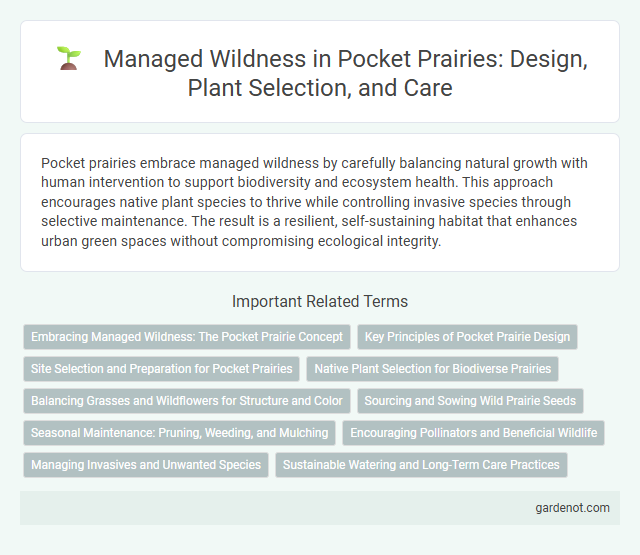Pocket prairies embrace managed wildness by carefully balancing natural growth with human intervention to support biodiversity and ecosystem health. This approach encourages native plant species to thrive while controlling invasive species through selective maintenance. The result is a resilient, self-sustaining habitat that enhances urban green spaces without compromising ecological integrity.
Embracing Managed Wildness: The Pocket Prairie Concept
Pocket Prairies embody the concept of managed wildness by blending natural ecosystems with strategic human intervention to enhance biodiversity in urban and suburban settings. These small-scale prairie restorations prioritize native plant species, creating habitats that support pollinators, birds, and beneficial insects while requiring minimal maintenance. By fostering ecological balance and resilience, pocket prairies contribute to climate adaptation, soil health, and community engagement in conservation efforts.
Key Principles of Pocket Prairie Design
Managed wildness in pocket prairie design emphasizes maintaining native plant diversity and ecological resilience by mimicking natural prairie ecosystems at a small scale. Key principles include selecting regionally appropriate native species, fostering structural diversity through varied plant heights and growth forms, and implementing adaptive management like seasonal burning or mowing to sustain habitat health. This approach balances human intervention with natural processes, promoting biodiversity and ecosystem services within urban or residential landscapes.
Site Selection and Preparation for Pocket Prairies
Site selection for pocket prairies requires assessing soil quality, sunlight exposure, and existing native vegetation to ensure optimal growth and biodiversity. Preparing the site involves removing invasive species, loosening compacted soil, and layering organic matter to create a nutrient-rich foundation. These steps enhance managed wildness by promoting native plant establishment and supporting local ecosystems.
Native Plant Selection for Biodiverse Prairies
Native plant selection plays a critical role in managed wildness within pocket prairies by enhancing biodiversity and ecosystem resilience. Choosing regionally appropriate grasses and wildflowers supports pollinators, soil health, and wildlife habitats, creating a self-sustaining environment that mimics natural prairie dynamics. Incorporating a variety of native species with staggered bloom times ensures continuous food resources and fosters a balanced, thriving prairie ecosystem.
Balancing Grasses and Wildflowers for Structure and Color
Balancing native grasses and wildflowers in pocket prairies enhances structural diversity and seasonal color variation, supporting a range of pollinators and wildlife. Selecting species with staggered bloom times and varying heights creates visual interest while maintaining ecological function. Proper management ensures grasses provide habitat stability, while wildflowers contribute vibrant hues and foraging resources throughout the growing season.
Sourcing and Sowing Wild Prairie Seeds
Managed wildness in pocket prairies emphasizes sourcing native wild prairie seeds from local, genetically diverse populations to ensure ecosystem resilience and adaptability. Sowing techniques prioritize seasonal timing and soil preparation that mimic natural disturbances, promoting seed germination and establishment. This approach supports biodiversity by restoring native plant communities and providing habitat for pollinators and wildlife.
Seasonal Maintenance: Pruning, Weeding, and Mulching
Seasonal maintenance in a pocket prairie emphasizes pruning to remove dead or invasive plants, promoting healthy growth and biodiversity. Regular weeding controls unwanted species that compete with native flora, ensuring the ecosystem remains balanced. Mulching conserves soil moisture, suppresses weeds, and enhances nutrient cycling, supporting robust plant development throughout the year.
Encouraging Pollinators and Beneficial Wildlife
Pocket prairies provide essential habitats that encourage pollinators such as bees, butterflies, and hummingbirds by offering native flowering plants rich in nectar and pollen. These areas support beneficial wildlife including predatory insects and birds that naturally control pests, enhancing ecosystem balance and reducing the need for chemical interventions. Proper management practices, like seasonal mowing and planting diverse native species, maximize habitat quality and biodiversity within small urban or suburban spaces.
Managing Invasives and Unwanted Species
Managing invasives and unwanted species in a pocket prairie is essential for maintaining native biodiversity and ecosystem stability. Effective strategies include regular monitoring, targeted herbicide application, and manual removal to control species like Canada thistle and leafy spurge. Maintaining native plant dominance reduces competition, supports pollinators, and promotes long-term prairie health.
Sustainable Watering and Long-Term Care Practices
Pocket prairie management emphasizes sustainable watering techniques such as drip irrigation and rainwater harvesting to maintain native plant resilience while conserving water resources. Long-term care practices include periodic monitoring of soil moisture, mulching to reduce evaporation, and encouraging biodiversity to enhance ecosystem stability and reduce maintenance needs. These approaches ensure ecological balance and promote sustained habitat health within urban environments.
Managed wildness Infographic

 gardenot.com
gardenot.com